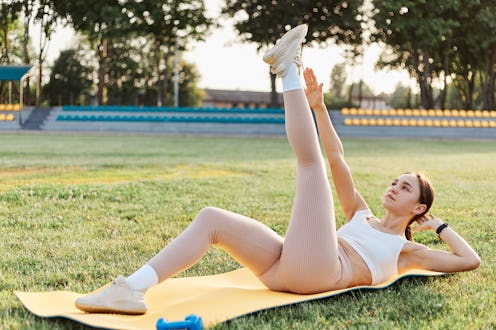Fitness
5 Vertical Leg Crunch Variations For Stronger Abs
It's time to change it up.

You can always turn to classic crunches and sit-ups to strengthen your core. And yet, if you want to reach new muscle groups — or simply can’t imagine doing another same-y crunch — then a few sets of vertical leg crunches might feel right.
Vertical crunches are just what they sound like: Crunches that you perform with your legs held up vertically so that they’re perpendicular to the floor, says Dr. Helen Goldstein, a doctor of physical therapy with FlexIt Fitness. And there are all sorts of benefits to be gained by crunching this way. A legs-up position helps target your rectus abdominis muscles or abs, Goldstein tells Bustle, and it also calls on the obliques in a pretty unique way.
“Although we typically think of oblique strengthening exercises occurring during side bending or rotation type exercises, the obliques also assist in flexion of the trunk,” Goldstein says. As soon as you lift your legs up, you’ll notice that the muscles on the sides of your core really do light up to help keep you steady.
Another perk? “Vertical crunches also work the back extensor muscles, hip flexors, and even provide a little stimulus for the glutes and hamstrings, as they’re used to keep your legs in the air,” Matt Scarfo, a NASM-certified personal trainer, tells Bustle. Improved strength and core stability can result in better posture, too! Here are a few vertical leg crunch variations to try.
1. Classic Vertical Leg Crunch
Here, Goldstein shares how to do the classic version of the vertical leg crunch with good form.
- Lie on your back.
- Lift your legs up so that they’re perpendicular to the ground. Keep your knees straight.
- Place your hands behind your head with your elbows extended out to the sides, or reach your arms up.
- Inhale, then exhale as you lift your head and shoulders off the ground.
- If your hands are behind your head, crunch without pulling on your neck.
- Maintain space between your chin and chest.
- Feel your upper core contract.
- Slowly lower back down to the starting position.
- Aim for 15 to 20 reps, 3 sets.
2. Bent Knee Vertical Leg Crunch
Repeat the exact motion as above, but this time bend your knees. According to Goldstein, this variation is great if you have tight hamstrings. And Scarfo says it’s ideal for beginners, too, since it takes some of the pressure off your core.
- Lie on the ground.
- Lift your legs up perpendicular to the ground. Bend your knees slightly.
-Place your hands behind your head with your elbows extended out to the sides, or reach your arms up.
- Inhale, then exhale as you lift your head and shoulders off the ground.
- If your hands are behind your head, crunch without pulling on your neck.
- Maintain space between your chin and chest.
- Feel your upper core contract.
- Slowly lower back down to the starting position.
- Aim for 15 to 20 reps, 3 sets.
3. Vertical Leg Cross Crunch
Goldstein also recommends this version of the vertical leg crunch.
- Lie on the ground.
- Lift your legs up until they’re perpendicular to the ground.
- Keep your knees straight.
- Inhale, then exhale as you lift your head and shoulders off the ground.
- Maintain space between your chin and chest as you reach your right hand towards your left foot.
- Your right shoulder blade should lift further off the ground than your left.
- Lower back down to the starting position with control.
- Repeat on the other side with your left hand reaching towards your right foot.
- You should feel your upper core contract with each rep.
- Do 8 to 10 reps on each side, alternating. Aim for 3 sets.
4. Weighted Vertical Crunch
Kris Ceniza, a trainer and physiotherapist, suggests this version.
- Lie flat on the floor.
- Raise both feet to the ceiling while keeping your knees as straight as you can. (A slight bend is fine.)
- Keep your core activated by tilting your pelvis backward so more of your lower back is in contact with your mats.
- Hold your desired weight plate firmly in both hands. Push your arms straight up above your chest.
- Push the weight up to your toes, and contract your abs.
- Repeat 15 times, 3 sets.
- Increase repetitions as necessary.
5. Alternating Vertical Leg Crunch
Ceniza says you can also focus on one leg at a time.
- Lie flat on the floor.
- With one hand on top of the other, and your arms back behind you as if you're reaching for the wall behind you, simultaneously raise one leg and both arms to the ceiling.
- Crunch your abs.
- Slowly lower your limbs back to the floor and repeat with the opposite leg for one rep.
- Repeat 15 reps, 3 sets.
- Increase repetitions as necessary.
Studies referenced:
Hsu, SL. 2018. Effects of core strength training on core stability. J Phys Ther Sci. doi: 10.1589/jpts.30.1014.
Sources:
Dr. Helen Goldstein, doctor of physical therapy with FlexIt Fitness
Matt Scarfo, NASM-certified personal trainer
Kris Ceniza, trainer and physiotherapist
This article was originally published on